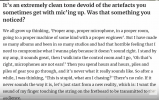The sound of a modeler
does not "have to be the sound of a mic'd amp."
The sound of an impulse response
does.
My first point is semantical, so let me explain: you can connect the output of an amp modeler -- with cab sims turned off -- to a power amp and any guitar cab. That guitar cab will then sound
like itself, demonstrating all of the sonic and physically interactive properties that make it unique, and interacting with the environment around itself to present the expected experience. Our products are designed to support this application and it is a popular way that they are used.
If you examine a guitar speaker cabinet, however, you will find that some of the properties that make it sound "like itself" also make it more challenging to reproduce when using a full range speaker like a studio monitor (or PA or headphones, etc.)
For example, how can a studio monitor or FRFR guitar speaker project backwards the way an open backed cab does, or change its "beaming pattern" to create the experience of different sized speakers or cabs? Or create the phasing effects of multiple speakers in a single cabinet? Or behave like it's on the floor when it's actually at ear level?
View attachment 100907



